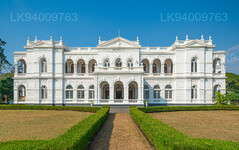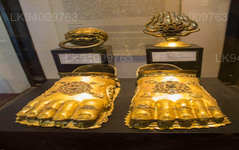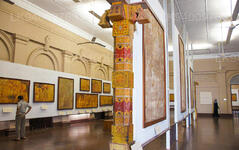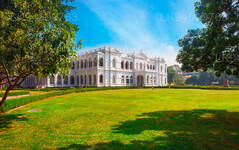
Colombo City
Colombo, hovedstaden i Sri Lanka, er en dynamisk by, der blander tradition og modernitet. Den fremviser kolonial arkitektur, livlige markeder og fredfyldte buddhistiske templer. Med et varieret køkken, en voksende skyline og smukke strande er det et pulserende knudepunkt for forretning, kultur og turisme, der tilbyder en indgang til at udforske Sri Lankas vidundere.
National Museum
National Museum of Sri Lanka: The House of History
The National Museum of Sri Lanka, also most commonly known as the Sri Lanka National Museum is cosidered to be the largest Museum in Sri Lanka. It is maintained by its own dedicated Department of National Museum in Sri Lanka. It is home to many valuable and historically important objects such as the throne and the crown of the Kandyan Monarchs.
National Museum of Sri Lanka: The Story behind the History
The Colombo Museum was established in 1st January 1877. It was founded by the British Governor of Ceylon at the time; Sir William Gregory.
The architect of the Public Works department, J.G. Smither was able to prepare plans for the new structure based on Italian architecture style.
The construction of the Museum was carried out by Arasi Marikar Wapchie Marikar (born 1829, died 1925, aka Wapchi Marikar Bass. Wapchi Marikar Bass has an extensive resume that made him the perfect man for this immense project. He was the builder of the General Post Office in Colombo, Colombo Customs, Old Town Hall in Pettah, Galle Face Hotel, Victoria Arcade, Finlay Moir building, the Clock Tower, Batternburg Battery and many other buildings some of which are still standing today. The construction was completed in 1876 and commissioned to be opened the following year. The completed building of the Colombo Museum was declared open by Governor Gregory, in the presence of a large crowd.
Several other wings were added from time to time under the direction of Dr. Arthur Willey and Dr. Joseph Pearson new structures were built during the period of Dr. P. E. P. Deraniyagala, Dr. P. H. D. H. de Silva and Sirinimal Lakdusinghe. One of the natural history museum, and yet another consists of the auditorium.
National Museum of Sri Lanka: Recent developments
The museum was given the status of a national museum during the period of P. E. P. Deraniyagala. Under his supervision branch museums were opened in Jaffna, Kandy, and Ratnapura and a fully-fledged department of national museum was established in 1942 under the act No. 31. Nine branch museums were ultimately opened, and a school science program and a mobile museum law essay writing uk service are also in operation.
National Museum of Sri Lanka: The Library
Along with the Colombo National Museum the Library was also established in the 1st of January in 1877. The Government Oriental library (1870) was incorporated in to Colombo National Museum Library, and served as the nucleus of the library collection by collecting the local publications during the past 129 years.This huge collection of the library could be separated in to various groups according to the document type.
1. Palm leaf collection which are written in Sinhala, Pali, Sanskrit, Burmese, Telegu and Tamil characters among the subjects covered are Buddhism, Sinhala literature, History, Indigenous Medicine, Astrology, Demonology, Veterinary Science, Art, Architecture and Folklore.
2. Printed books and Pamphlets, This collection comprises the entire range of documents from the first work printed in 1737 to the latest book.
3. Periodical collections such as Journal of the Royal Asiatic Society (CB), Ceylon Antiquary and Literary Register, Young Ceylon etc. The collection was built up to a great extent by exchanges received from the institutions in all parts of the globe. Foreign periodical collection contains important titles such as discovery reports, Ray Society publications among many others.
4. Government Publications such as Blue books from 1864-1938, Administration Reports from 1867 to date, Sessional papers from 1860 up to date, Hansards
from 1863-1962 etc.
5. Directories, Statistical year books, Trade catalogues etc.
6. Law Reports
7. Maps and Drawings
National Museum of Sri Lanka: Photography Division
The Photography Division of the Department of National Museums was established in 1950. Photographs related to the museum objects supply to other divisions of the department and external parties is the main task of this division.
Services of this division are:
Photograph museum objects, faunal and floral specimen, geological items and supply photographs to the relevant divisions where necessary. Sale of photographs of museum objects to external parties with the orderly approval from the Director. Negatives, photographs taken by the digital camera store on CD’s, registration and conservation.
National Museum of Sri Lanka: Information Technology division
The Information Technology division of National Museum of Sri Lanka is used to archive the all the data in the Museum and save it in a safe form. It also takes care of online queries and maintaining the museum web page.
Om Colombo-distriktet
Colombo er Sri Lankas største by og handelshovedstad. Den ligger på øens vestkyst og støder op til Sri Jayewardenepura Kotte, Sri Lankas hovedstad. Colombo er en travl og pulserende by med en blanding af moderne liv og koloniale bygninger og ruiner og en bybefolkning på 647.100. Colombo Metropolitan Region, defineret af distrikterne Colombo, Gampaha og Kalutara, har en anslået befolkning på 5.648.000 og dækker et areal på 3.694,20 km². Colombo er en multietnisk, multikulturel by. Det er den mest folkerige by i Sri Lanka med 642.163 mennesker, der bor inden for bygrænsen. Befolkningen i Colombo er en blanding af adskillige etniske grupper, primært singalesere, maurere og tamiler. Der er også små samfund af mennesker med kinesisk, portugisisk, hollandsk, malaysisk og indisk oprindelse, der bor i byen, samt adskillige europæiske udlændinge. Langt de fleste srilankanske virksomheder har deres hovedkontorer i Colombo. Nogle af industrierne omfatter kemikalier, tekstiler, glas, cement, lædervarer, møbler og smykker. I byens centrum ligger Sydasiens næsthøjeste bygning - World Trade Center.
Om Vestprovinsen
Vestprovinsen er den tættest befolkede provins i Sri Lanka. Den er hjemsted for den lovgivende hovedstad Sri Jayawardenepura Kotte samt Colombo, landets administrative og forretningsmæssige centrum. Vestprovinsen er opdelt i 3 hoveddistrikter kaldet Colombo (642 km²), Gampaha (1.386,6 km²) og Kalutara (1.606 km²). Som Sri Lankas økonomiske centrum er alle de store lokale og internationale virksomheder til stede i byen, ligesom alle de store designer- og detailhandlere, så vær klar til at forkæle dig selv med lidt shoppingterapi i den vestlige provins. Med den højeste befolkning i alle provinser er næsten alle de førende uddannelsesinstitutioner på øen placeret i den vestlige provins. Universiteterne i provinsen omfatter University of Colombo, University of Sri Jayewardenepura, University of Kelaniya, Open University, Sri Lanka, Buddhist and Pali University of Sri Lanka, General Sir John Kotelawala Defence University og University of Moratuwa. Den vestlige provins har det største antal skoler i landet, herunder nationale, provinsielle, private og internationale skoler.










































